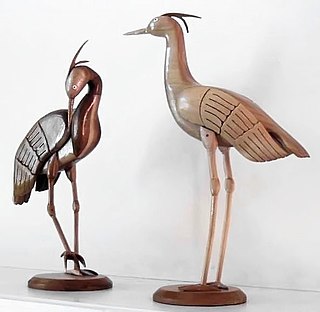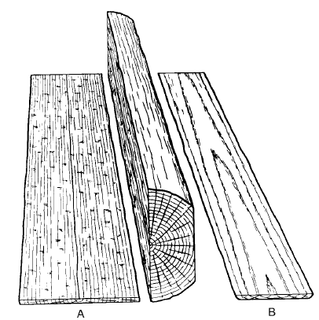
The International Organization for Standardization is an international standard-setting body composed of representatives from various national standards organizations.

Woodworking is the skill of making items from wood, and includes cabinet making, wood carving, joinery, carpentry, and woodturning.

The Alfred Wegener Institute, Helmholtz Centre for Polar and Marine Research is located in Bremerhaven, Germany, and a member of the Helmholtz Association of German Research Centres. It conducts research in the Arctic, the Antarctic, and the high and mid latitude oceans. Additional research topics are: North Sea research, marine biological monitoring, and technical marine developments. The institute was founded in 1980 and is named after meteorologist, climatologist, and geologist Alfred Wegener.
The eighth edition of the Quality Standards (QSI) is a major revision in a line of Standards extending back to 1961.

Sharpening stones, or whetstones, are used to sharpen the edges of steel tools and implements, such as knives, scissors, scythes, razors, chisels, hand scrapers, and plane blades, through grinding and honing.

Wainwright Airport is a public use airport located in Wainwright, a city in the North Slope Borough of the U.S. state of Alaska. The airport is owned by the North Slope Borough.

Agew Awi is one of 11 Zones in the Amhara Region of Ethiopia. It is named for the Awi sub-group of the Agaw people, some of whom live in this Zone. Agew Awi Zone is bordered on the west by Benishangul-Gumuz Region, on the north by Semien Gondar Zone and on the east by Mirab Gojjam. The administrative centre of Agew Awi is Injibara; other towns include Chagni, Agew Gimjabet, Tilili, Adis Kidame, Azena, Zigem and Dangila.
Warembori is a moribund language spoken by about 600 people in Warembori village, Mamberamo Hilir District, Mamberamo Raya Regency, located around river mouths on the north coast of Papua, Indonesia.
The Animal Welfare Institute (AWI) is an American non-profit charitable organization founded by Christine Stevens in 1951 with the goal of reducing suffering inflicted on animals by humans. It is one of the oldest animal welfare organizations in the US. Its legislative division, the Society for Animal Protective Legislation (SAPL), pushes for the passage of laws that reflect this purpose.
The Association for Women in Science (AWIS) was founded in 1971 at the annual Federation of American Societies for Experimental Biology (FASEB) meeting. The organization aims to combat job discrimination, lower pay, and professional isolation. The main issue areas that the modern Association addresses are fair compensation, work-life integration, attrition, and professional development.
The Awi people are an ethnic group in Ethiopia and are one of the Agaw peoples. The Awi live in Agew Awi Zone in central Gojjam and have a few communities in the Metekel Zone of the Benishangul-Gumuz Region.
The Awi people are composed of seven subgroups, called Ankäša, Azäna, Chara, Qʷaqura, Banʤa, Zigän and Mätäkäl. All Awi groups are classified to the Agaw line (አገው). These Awi mainly live in the Agäw Awi Zone located central Gojjam, whereas small numbers of Awi groups as well reside in Mätäkäl Zone, neighboring Benishangul-Gumuz Region.

Resourcesat-2 is a follow on mission to Resourcesat-1 and the eighteenth Indian remote sensing satellite built by Indian Space Research Organisation (ISRO). The new satellite provides the same services as the original Resourcesat-1, but was also designed to "provide data with enhanced multispectral and spatial coverage". Compared to Resourcesat-1, LISS-4 multispectral swath has been enhanced from 23 km to 70 km based on user needs. Suitable changes including miniaturization in payload electronics have been incorporated in Resourcesat-2.
Rift-sawing is a woodworking process that aims to produce lumber that is less vulnerable to distortion than flat sawn lumber. Rift-sawing may be done strictly along a log's radials—perpendicular to the annular growth ring orientation or wood grain—or as part of the quarter sawing process.
Woolmark is a wool industry certification mark used on pure wool products that meet quality standards set by The Woolmark Company. It is a trade mark owned by The Woolmark Company, which has since 2007 been a subsidiary of Australian Wool Innovation Limited (AWI). The logo was launched in 1964 by the Woolmark Company under its previous name, the International Wool Secretariat.
Duncan Na'awi is a Papua New Guinean rugby league footballer who represented Papua New Guinea in the 2000 World Cup.

The International Wool Secretariat (IWS) was formed in 1937 to promote the sale of wool on behalf of woolgrowers and review research carried out by independent bodies such as the Wool Industries' Research Association at Torridon, Headingley Lane, Leeds, England.

Flat sawing, flitch sawing or plain sawing is a woodworking process that produces flat cut or plain cut boards of lumber.

A Warrington hammer is a type of cross-peen hammer commonly used in woodworking. Other names for the Warrington hammer include joiners' hammer, English pattern hammer, and Warrington pattern hammer.

A square is a tool used for marking and referencing a 90° angle, though mitre squares are used for 45° angles. Squares see common use in woodworking, metalworking, construction and technical drawing. Some squares incorporate a scale for measuring distances or for calculating angles.











